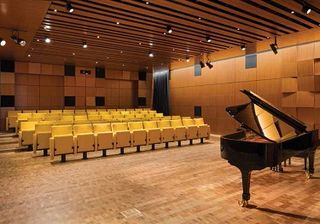When your previous home was registered as a cultural historical landmark, that’s a tough act to follow. Fortunately, the new Steinway Hall in the heart of New York City’s Midtown has appeal, AV innovation, and architectural excellence aplenty—more than enough to make piano purists worldwide welcome the advanced home of this beloved musical brand.

The recital hall sports a custom Steinway Lyngdorf system supporting both stereo and immersive formats, with 40-plus channels of digital amplification across 51 individual speakers. Steinway pulled up stakes from its famed Manhattan space on 57th Street to open this breathtaking new location on 43rd Street, selecting Arup to oversee acoustic, audiovisual, IT communications, and security design services for the facility. Close collaboration every step of the way with the firm Selldorf Architects amplified the possibilities for the 19,000-square-foot space consisting of a retail showroom, a 74-seat multipurpose recital room, offices, tuning, and practice rooms.
“Steinway has such a rich history, and they’re considered to be the best in the world, so the idea of taking part in a space like this meant matching that standard of quality,” said Nathan Blum, associate of acoustics, AV and Theater Group for Arup. “In addition to being a retail showcase, this also had to be a multi-functional space for artists— Steinway sees its artists as brand ambassadors, so making them feel more comfortable was key.”
The heart of the space is actually the recital room downstairs, a highly flexible theater ideal for intimate live performances, cinematic showings, and live streaming. It also serves as a recording studio that can capture not only standard acoustic pianos, but also the new Steinway Spirio high-resolution player piano.
Artists and audiences alike are treated to a unique experience in the performance space, which sports a custom Steinway Lyngdorf system supporting both stereo and immersive formats including Dolby Atmos and DTS:X. In all, it sports 40-plus channels of digital amplification across 51 individual speakers, and stands as the first Steinway Lyngdorf Model LS immersive sound system installed in a public recital hall worldwide.
Blum, Arup consultant Marcelo Gregorio, and AV integrator Tritech had a learning curve to incorporate the Steinway Lyngdorf system, since the brand is traditionally slated for high-end consumer applications. “It was our job to integrate the Steinway Lyngdorf system with audio/video gear from different manufacturers in order to manage additional inputs and outputs,” said Blum. “We designed acoustically transparent panels to go in front of the 32 surround system speakers, which integrate the loudspeakers within the custom wall panel system. There are also curtains that serve as variable acoustics to further control the space, providing flexibility depending on what’s being performed.”
Blum described the musical result as “cinematic and powerful,” but speech is also clear as a bell due to a separate speech reinforcement system. Two Shure SM58 wireless microphones and six Meyer M4 speakers handle speech duties for introductions, lectures, and panel discussions, while BSS Soundweb audio processing with Dante is used for both music and speech.
On the video side, playback in the hall is based on HDBaseT distribution connected via Extron video extension. For video recording, Arup specified three ceiling-mounted Panasonic AW-HE130K 1080p cameras and a Panasonic AV-HS450NJ live switcher.

The recording studio can capture not only standard acoustic pianos, but also the new Steinway Spirio high-resolution player piano. “The main camera requirements were that they be HD and controllable via IP,” said Blum. “They also had to be architecturally sensitive and unobtrusive. They were located so that the view of the cameras wasn’t blocked by any elements in the ceiling such as speakers or light fixtures. There’s actually quite a lot going on in the ceiling—it’s spring-isolated so that sound from the recital room doesn’t transfer up into the retail space—so we spent a lot of time coordinating that.”
The nerve center of Steinway Hall is a multipurpose control room that’s also on the lower level, where audio and video recording stations, as well as routing for the entire facility, are all based. “That control room is the main hub of everything,” Blum said. “It supports the recital room and the retail spaces, which have their own loudspeakers plus a video wall upstairs.”
To keep everything moving smoothly, Arup collaborated closely with Tritech project manager Anthony Melfa and Steinway personnel to define all control requirements for a Crestron AV3 system that can be easily guided wirelessly via iPad. “A lot of different people needed to be able to control the recital hall and its functions,” said Blum. “The interface is very intuitive and clear, with presets for presentation, cinema, live performance, Spirio recording, and more. The control system instantly adjusts everything from the AV system to the lights and the curtains.”
While AV is key to the harmonious gathering of elements at the new Steinway Hall, Arup’s Blum points out that only a finely tuned ensemble could have created such an inspirational space. “The successful collaboration with Selldorf Architects was essential,” he said. “They pushed us to do new things on the acoustics and technology side, and they were likewise pushed to understand our requirements. That elevated everybody to the elite performance level that Steinway represents.”
David Weiss (dwords.com) writes extensively about AV, audio, and broadcast technology.

